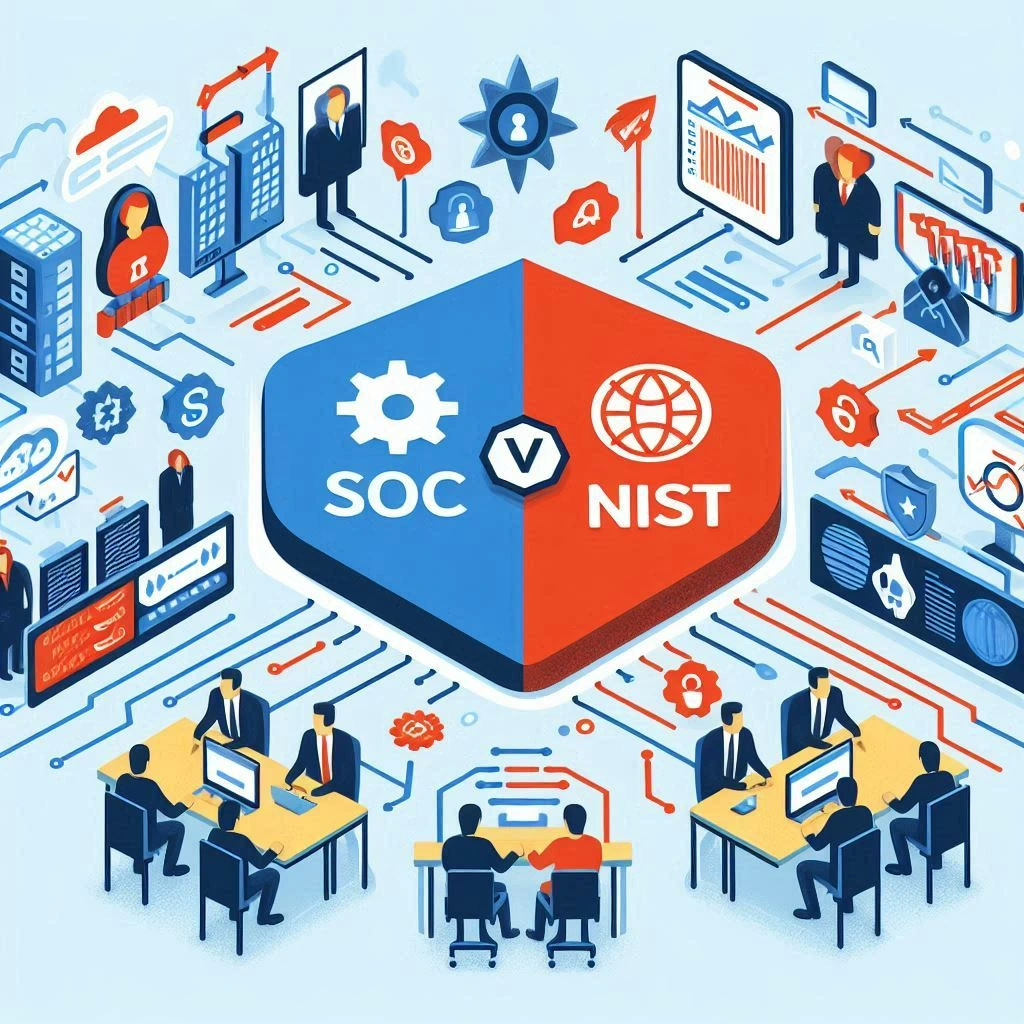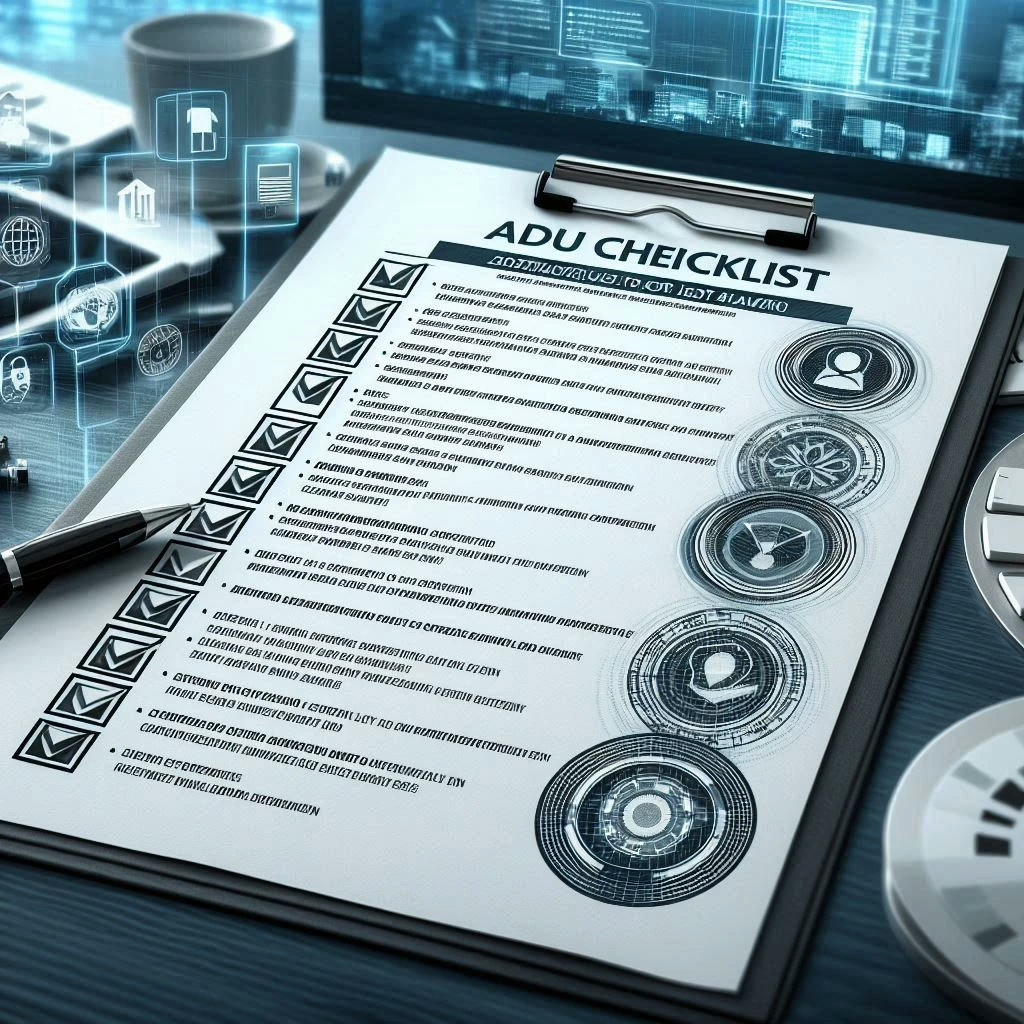Introduction
In an increasingly complex business landscape, organizations are faced with the critical task of ensuring compliance with various regulatory standards. Among the most prominent frameworks are SOC 2 and NIST, each serving distinct purposes and offering unique benefits. Understanding these frameworks is essential for C-level executives and compliance teams as they navigate the intricacies of regulatory requirements and strive to build trust with stakeholders.
Defining SOC 2 and NIST Frameworks
SOC 2, or Service Organization Control 2, is an auditing framework specifically designed for service providers that handle customer data. It focuses on five Trust Service Criteria: security, availability, processing integrity, confidentiality, and privacy. A successful SOC 2 audit results in an independent report that validates an organization’s adherence to these criteria, which can be crucial for gaining customer trust and meeting contractual obligations [1][8].
On the other hand, the National Institute of Standards and Technology (NIST) provides a set of guidelines and standards aimed at improving cybersecurity practices across various sectors. NIST SP 800-53, for instance, outlines security and privacy controls for federal information systems and organizations, emphasizing a risk management approach to protect sensitive data [5][14]. Unlike SOC 2, NIST does not offer certification but serves as a voluntary framework that organizations can adopt to enhance their cybersecurity posture [11][15].
The Significance of Compliance in Today’s Business Environment
In today’s digital age, compliance is not merely a regulatory obligation; it is a fundamental component of an organization’s operational integrity and reputation. With increasing scrutiny from regulators, customers, and business partners, organizations must demonstrate their commitment to safeguarding sensitive information. Compliance frameworks like SOC 2 and NIST provide structured approaches to managing risks and ensuring that organizations meet industry standards [1][12].
Moreover, the consequences of non-compliance can be severe, ranging from financial penalties to reputational damage. As such, organizations must prioritize compliance as part of their strategic objectives, ensuring that they not only meet current requirements but also adapt to evolving regulatory landscapes [1][12].
Target Audience and Decision-Making Context
This discussion is particularly relevant for C-level executives and compliance teams who are tasked with making informed decisions about which compliance frameworks to adopt. The choice between SOC 2 and NIST can significantly impact an organization’s operational strategy, risk management practices, and overall cybersecurity posture. By understanding the nuances of each framework, decision-makers can align their compliance efforts with organizational goals, ultimately fostering a culture of trust and accountability [1][3][11].
In conclusion, as organizations strive to navigate the complexities of compliance, a thorough understanding of SOC 2 and NIST frameworks is essential. This knowledge empowers leaders to make strategic decisions that not only fulfill regulatory requirements but also enhance their organization’s resilience in the face of emerging threats.
Understanding SOC 2
SOC 2, or Service Organization Control 2, is a compliance framework developed by the American Institute of Certified Public Accountants (AICPA). It was designed to help service organizations demonstrate their commitment to managing customer data securely and effectively. The framework is particularly relevant for companies that handle sensitive information, especially in the cloud computing sector. SOC 2 compliance is not a one-size-fits-all approach; it allows organizations to tailor their controls based on their specific operational needs and the nature of the services they provide [2][3].
Key Principles of SOC 2
SOC 2 is built upon five Trust Service Criteria, which are essential for ensuring the integrity and security of customer data:
- Security: Protecting against unauthorized access and ensuring the integrity of systems.
- Availability: Ensuring that systems are operational and accessible as agreed upon.
- Processing Integrity: Guaranteeing that system processing is complete, valid, accurate, and authorized.
- Confidentiality: Protecting sensitive information from unauthorized disclosure.
- Privacy: Safeguarding personal information in accordance with privacy policies and regulations [6][8].
These principles serve as the foundation for SOC 2 compliance, guiding organizations in establishing robust controls that align with their operational goals.
Benefits of SOC 2 Compliance for Organizations
Achieving SOC 2 compliance offers several advantages, particularly for organizations in the technology and service sectors:
- Enhanced Trust: A SOC 2 report provides assurance to customers and stakeholders that the organization is committed to maintaining high standards of data security and privacy.
- Competitive Advantage: In a market where data breaches are prevalent, having a SOC 2 compliance report can differentiate an organization from its competitors, making it more attractive to potential clients.
- Risk Mitigation: By implementing the controls required for SOC 2 compliance, organizations can identify and address vulnerabilities, thereby reducing the risk of data breaches and associated financial losses [4][14].
- Regulatory Alignment: SOC 2 compliance can help organizations align with other regulatory requirements, making it easier to navigate the complex landscape of data protection laws [10].
Common Misconceptions and Pitfalls in Implementing SOC 2
Despite its benefits, there are several misconceptions and pitfalls that organizations may encounter when pursuing SOC 2 compliance:
- Misunderstanding the Audit Process: Some organizations believe that achieving SOC 2 compliance is merely about passing an audit. In reality, it requires ongoing commitment to maintaining and improving security controls [4][15].
- Overlooking Tailoring Needs: Organizations may assume that a generic approach to SOC 2 compliance will suffice. However, it is crucial to tailor controls to the specific risks and operational context of the organization [1][3].
- Neglecting Employee Training: Implementing SOC 2 controls without proper training and awareness among employees can lead to ineffective security practices. Continuous education is essential for fostering a culture of compliance [11][14].
By understanding these aspects of SOC 2, organizations can make informed decisions about their compliance strategies, ensuring they not only meet regulatory requirements but also enhance their overall security posture.
Understanding NIST
The National Institute of Standards and Technology (NIST) plays a crucial role in establishing standards and guidelines that help organizations manage and reduce cybersecurity risks. NIST provides a variety of frameworks, with the most notable being the NIST Cybersecurity Framework (CSF) and NIST SP 800-53, which are designed to enhance the security posture of organizations across various sectors.
Overview of NIST
- Purpose and Frameworks: NIST’s primary purpose is to develop standards that improve the security and resilience of information systems. The NIST Cybersecurity Framework (CSF) is a voluntary framework that provides a policy framework of computer security guidance for how private sector organizations can assess and improve their ability to prevent, detect, and respond to cyber attacks. NIST SP 800-53, on the other hand, offers a catalog of security and privacy controls for federal information systems and organizations, ensuring compliance with federal regulations and enhancing overall security measures [6][10].
Key Components of NIST
- Risk Management: NIST emphasizes a risk-based approach to cybersecurity, encouraging organizations to identify, assess, and prioritize risks to their information systems. This proactive stance allows organizations to allocate resources effectively and mitigate potential threats before they materialize [6][10].
- Security Controls: The NIST frameworks provide a comprehensive set of security controls that organizations can implement to protect their information systems. These controls cover various aspects of security, including access control, incident response, and system integrity, ensuring a holistic approach to cybersecurity [6][10].
- Continuous Monitoring: NIST advocates for continuous monitoring of security controls to ensure they remain effective over time. This ongoing process helps organizations adapt to new threats and vulnerabilities, maintaining a robust security posture [11].
Benefits of Following NIST Guidelines
- Enhanced Security: By adhering to NIST guidelines, organizations can significantly improve their cybersecurity defenses, particularly in sectors that are critical to national security and public safety, such as federal agencies and critical infrastructure providers [6][10].
- Regulatory Compliance: Many federal regulations require compliance with NIST standards, making it essential for organizations in these sectors to align their security practices with NIST guidelines. This alignment not only helps in meeting regulatory requirements but also fosters trust among stakeholders [10][12].
- Framework Flexibility: NIST frameworks are designed to be adaptable, allowing organizations to tailor their security measures based on their specific needs, risk tolerance, and operational context. This flexibility is particularly beneficial for organizations operating in diverse environments [6][10].
Addressing Common Challenges
Organizations often face several challenges when adopting NIST guidelines, including:
- Resource Allocation: Implementing NIST standards can require significant resources, including time, personnel, and financial investment. Organizations must carefully plan and allocate resources to ensure successful implementation [11][12].
- Complexity of Frameworks: The breadth of NIST guidelines can be overwhelming, especially for smaller organizations with limited expertise. It is essential for organizations to seek guidance and training to navigate the complexities of NIST frameworks effectively [11][12].
- Integration with Existing Processes: Organizations may struggle to integrate NIST guidelines with their existing security processes and frameworks. A strategic approach that aligns NIST standards with current practices can help mitigate this challenge [11][12].
SOC 2 vs NIST: Key Differences
When it comes to compliance frameworks, organizations often find themselves weighing the merits of SOC 2 and NIST. Both frameworks serve critical roles in enhancing data security and compliance, but they cater to different needs and contexts. Here’s a detailed comparison to help C-level executives and compliance teams make informed decisions.
Scope and Focus
- SOC 2: This framework is specifically designed for service organizations that handle customer data. It emphasizes the effectiveness of internal controls related to security, availability, processing integrity, confidentiality, and privacy of customer information. The primary goal is to provide assurance to clients and stakeholders that the organization is managing data securely and responsibly [2][11].
- NIST: In contrast, the NIST Cybersecurity Framework (CSF) has a broader applicability, serving various sectors beyond just service organizations. It provides a comprehensive risk management approach that helps organizations of all sizes and types to manage and reduce cybersecurity risks effectively. NIST focuses on actual data security and risk management rather than just internal controls [5][7].
Assessment and Reporting
- SOC 2: The assessment process for SOC 2 involves a formal audit conducted by an independent third party. Organizations receive a SOC 2 report that documents their compliance status, which can be crucial for building trust with customers and partners. This report is often required by clients as part of their vendor risk management processes [2][3][15].
- NIST: NIST does not provide a certification or formal audit process like SOC 2. Instead, it offers guidelines and best practices for organizations to follow. Compliance with NIST is often self-assessed, and while organizations can demonstrate adherence to its framework, they do not receive a formal report that certifies compliance [8][11].
Regulatory Considerations
- SOC 2: Compliance with SOC 2 can be essential for organizations that need to meet specific legal and regulatory requirements, especially in industries like finance and healthcare. The SOC 2 report can serve as evidence of compliance with various regulations, making it a valuable asset for organizations that must demonstrate their commitment to data security [2][3].
- NIST: The NIST framework is often aligned with federal regulations and is particularly relevant for organizations that handle Controlled Unclassified Information (CUI). Many government contracts require compliance with NIST standards, making it a critical framework for organizations in the public sector or those working with government entities [8][13].
Implementation Flexibility
- SOC 2: While SOC 2 provides a structured approach to compliance, it can be somewhat rigid in its requirements. Organizations must adhere to specific criteria to achieve compliance, which may not always align perfectly with their existing processes or risk management strategies [6][11].
- NIST: One of the key advantages of the NIST framework is its adaptability. Organizations can tailor the NIST guidelines to fit their unique operational needs and risk profiles. This flexibility allows for a more customized approach to cybersecurity, enabling organizations to implement controls that are most relevant to their specific context [10][12].
Factors to Consider When Choosing a Framework
When organizations are faced with the decision of selecting between SOC 2 and NIST frameworks, several critical factors must be evaluated to ensure that the chosen compliance path aligns with their unique circumstances. Here are the key points to consider:
- Assessing Organizational Size, Industry, and Risk Profile: The size and nature of an organization significantly influence the choice of compliance framework. SOC 2 is particularly tailored for service organizations that handle customer data, making it ideal for smaller to mid-sized companies focused on demonstrating control over sensitive information. In contrast, NIST provides a broader, voluntary framework suitable for any organization, regardless of size, that seeks to enhance its cybersecurity risk management practices. Organizations should assess their specific industry requirements and risk profiles to determine which framework best addresses their needs [3][4].
- Understanding Customer Requirements and Stakeholder Expectations: Organizations must consider the expectations of their customers and stakeholders when selecting a compliance framework. For instance, service-oriented businesses may find that SOC 2 aligns more closely with their clients’ demands for security and trust in data management. Conversely, organizations in sectors with stringent regulatory requirements may benefit from the comprehensive nature of NIST, which can be tailored to meet specific compliance obligations [7][13].
- Evaluating the Cost and Resource Implications of Each Framework: The financial and resource commitments associated with each framework can vary significantly. SOC 2 requires adherence to specific guidelines and an external audit conducted by a CPA firm, which can entail considerable costs and resource allocation [8][6]. On the other hand, NIST’s flexible framework allows organizations to implement security measures based on their unique needs, potentially offering a more cost-effective solution for some. Organizations should conduct a thorough cost-benefit analysis to understand the implications of each framework on their operations [10][12].
- Considering Long-Term Strategy and Compliance Goals: Organizations should align their choice of compliance framework with their long-term strategic objectives and compliance goals. SOC 2 is ideal for organizations aiming to build trust with customers and demonstrate a commitment to security and privacy. In contrast, NIST’s comprehensive approach may be more suitable for organizations looking to establish a robust cybersecurity program that evolves with emerging threats. Evaluating how each framework fits into the organization’s future plans can help ensure that the chosen path supports sustained compliance and risk management efforts [2][11][10].
By carefully considering these factors, organizations can make informed decisions that not only meet compliance requirements but also enhance their overall security posture and align with their strategic objectives.
Conclusion
In the landscape of compliance frameworks, both SOC 2 and NIST offer distinct advantages and serve different purposes, making it essential for organizations to carefully evaluate their needs before choosing a path forward. Here are the key takeaways regarding the differences and benefits of each framework:
- Main Differences: SOC 2 focuses on service organizations and evaluates their controls against the Trust Service Criteria, which include security, availability, processing integrity, confidentiality, and privacy. In contrast, NIST, particularly through its SP 800-53 framework, is broader and emphasizes a comprehensive approach to cybersecurity for federal organizations, requiring annual audits to ensure ongoing compliance [1][4][10].
- Benefits of SOC 2: Achieving SOC 2 compliance results in an independent audit report that can enhance trust with customers and partners, demonstrating that an organization has met specific security standards. This is particularly beneficial for service providers looking to establish credibility in the marketplace [1][10].
- Benefits of NIST: NIST provides a well-rounded Cybersecurity Framework that is adaptable across various sectors and technologies. It is particularly valuable for organizations handling sensitive government data, as it aligns with federal requirements and offers a structured approach to risk management [5][10].
Aligning the chosen framework with organizational goals is crucial. Organizations should consider their specific operational needs, regulatory requirements, and the expectations of stakeholders when deciding between SOC 2 and NIST. For instance, a cloud service provider may require SOC 2 for general business purposes while also needing to comply with NIST for federal contracts [13].
Before making a decision, it is advisable for organizations to conduct a thorough assessment of their current security posture, compliance requirements, and the resources available for implementing and maintaining the chosen framework. This assessment will help ensure that the selected framework not only meets compliance needs but also supports the organization’s overall strategic objectives.
Find out more about Shaun Stoltz https://www.shaunstoltz.com/about/
This post was written by an AI and reviewed/edited by a human.



